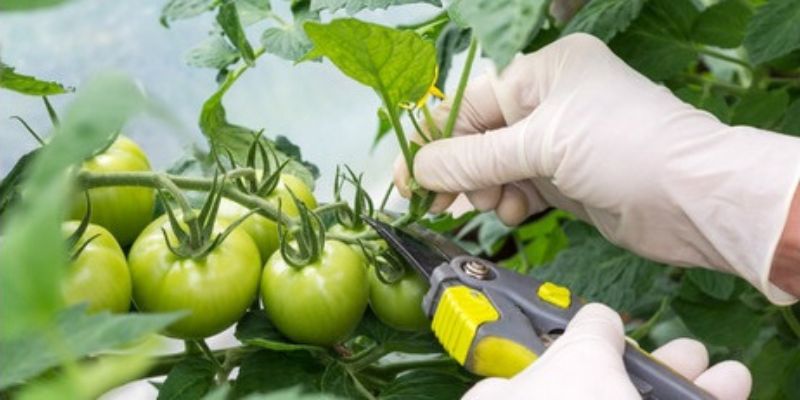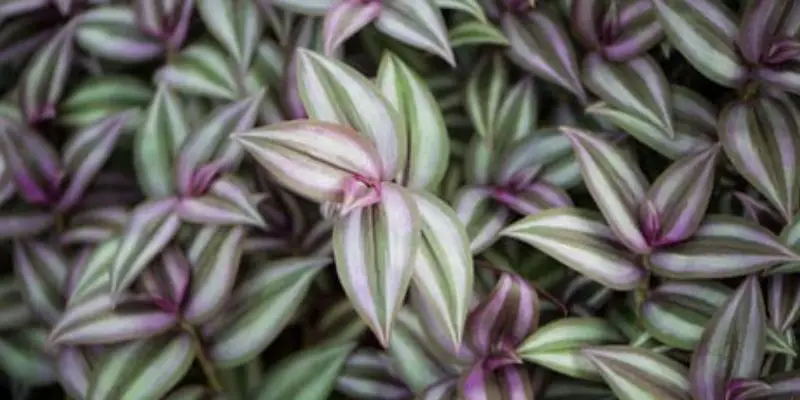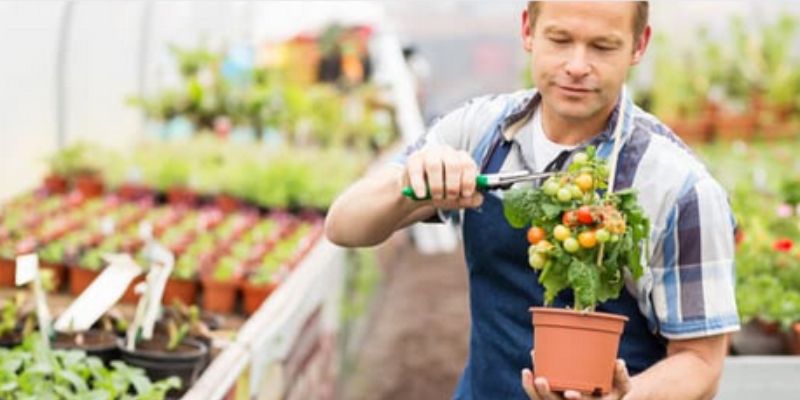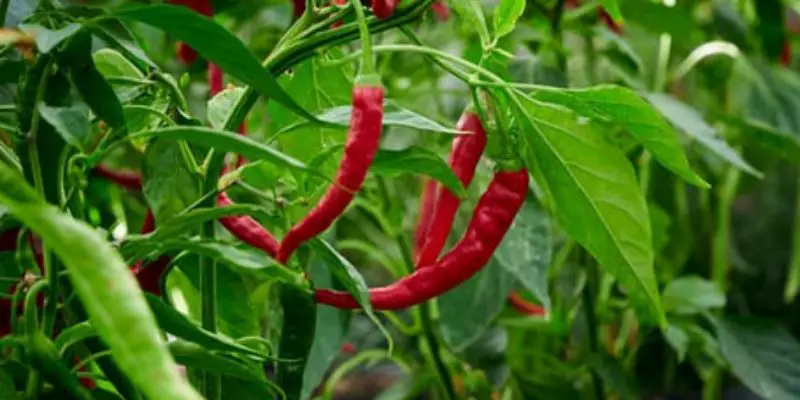Determinate tomato varieties only grow to a compact, pre-determined height, which makes proper pruning essential for maximizing fruit production. By removing excess foliage and stems, you allow better air circulation and light exposure for the plant to focus energy on developing plump, abundant tomatoes. This guide will explore the ins and outs of how to prune determinate tomato plants.
Determinate vs Indeterminate Tomatoes
As you explore the proper pruning methods for determinate tomatoes, it’s imperative to grasp the key distinctions between determinate and indeterminate varieties. Understanding these differences will guide you in adopting the ideal pruning approach tailored to each growth pattern.
Determinate Tomatoes: The Compact Marvels
Affectionately referred to as “bush” tomatoes, determinate varieties showcase a compact, bushy growth pattern. These plants reach a predetermined, fixed mature height, typically ranging from 3 to 5 feet tall. In contrast to their indeterminate counterparts, determinate plants cease vertical growth once they set fruit on the terminal (top) buds.
One of the primary advantages of determinate tomatoes lies in their diminutive stature, rendering them perfect candidates for container gardening or cultivating in supportive cages or stakes. Their compact size also means they require less intensive staking or trellising compared to indeterminate varieties.
However, the compact nature of determinate tomatoes also signifies that they greatly benefit from precise pruning techniques. Proper pruning not only aids in managing the plant’s size and shape but also redirects the plant’s energy towards fruit production, resulting in higher yields of larger, healthier tomatoes.
Indeterminate Tomatoes: The Vining Marvels
In contrast, indeterminate tomatoes are true vining plants that exhibit a rampant growth habit, continuously producing new foliage and fruit throughout the entire growing season. These varieties keep growing taller and taller, only halting their ascent when met with frost or disease.
Indeterminate tomato plants can easily soar to heights of 6 to 12 feet or more, making them less suitable for container gardening unless you possess a large, deep container and a sturdy support system. These vining plants necessitate heavy-duty staking, trellising, or caging to support their weight and prevent the vines from drooping or breaking under the burden of heavy fruit clusters.
While indeterminate tomatoes benefit from some pruning to control excessive foliage growth, the focus is less on shaping the plant and more on managing its rampant vining habit. Pruning primarily involves removing lower leaves and interior branches to improve air circulation and sunlight penetration.
Regarding yields, both determinate and indeterminate varieties can be prolific producers when cultivated under optimal conditions. However, due to their fixed height, determinate plants tend to produce their entire crop over a shorter period (usually 4 to 6 weeks), making them an excellent choice for those seeking tomatoes for canning or processing. Indeterminate varieties, on the other hand, produce fruit continually until the arrival of cold weather, providing a longer, more staggered harvest period.
Regardless of the type you cultivate, comprehending the fundamental growth habits of determinate and indeterminate tomatoes is crucial to tailoring your pruning, staking, and overall plant management techniques. With the appropriate approach, you can maximize yields, improve plant health, and revel in an abundant tomato harvest throughout the season.
When to Prune Determinate Tomatoes
As a savvy gardener, you know that properly pruned tomato plants are the key to a bountiful harvest. And when it comes to determinate varieties, the pruning game is slightly different from their indeterminate counterparts. Timing is everything when it comes to pruning, and determinate tomatoes have their own unique schedule. Let’s break it down:
i. At Planting Time
Your pruning journey begins right at the start – when you first transplant your seedlings into the garden or containers. This is the perfect opportunity to give your little tomato plants a head start. Gently remove any lower leaves and any branches that appear damaged or diseased. This simple step encourages robust root growth, setting the stage for a healthy, productive plant.
ii. When the Main Stems Take Shape
As your determinate tomato plants grow, they’ll start to form their main framework of branches – usually around 4-6 primary stems. Once you see this structure taking shape, it’s time for another round of pruning. Carefully trim away all but the 3-4 strongest, healthiest stems. This strategic pruning ensures that your plant’s energy is focused on these primary branches, resulting in larger, more bountiful fruit clusters.
iii. When Flowering and Fruit Set
Just when you think you’ve got the hang of this pruning thing, your determinate tomatoes will surprise you with their first flower clusters. This is the critical moment when you’ll want to take pruning to the next level. Carefully remove any side shoots or suckers that emerge from the main stems or leaf nodes. By doing this, you’ll redirect your plant’s energy away from excess foliage and towards those precious flower trusses and developing fruits.
One important note: resist the urge to prune your determinate tomatoes any later in the season. These compact plants have a fixed growth pattern, so late pruning can actually reduce your overall yield.
Tools Needed for Pruning Tomatoes
Having quality tools makes pruning tasks much easier:
- Bypass Hand Pruners – Make clean cuts on stems up to 1⁄2 inches thick
- Garden Scissors – Quickly snip smaller leaf stalks and delicate growth
- Disinfectant Spray – Prevent the spreading of diseases between plants
- Gardening Gloves – Protect hands from sap and thorns
- Tote Bag – For collecting and discarding clippings
Keep tools sharp and sanitize regularly with household cleaners for best results.
How to Prune Determinate Tomato Plants
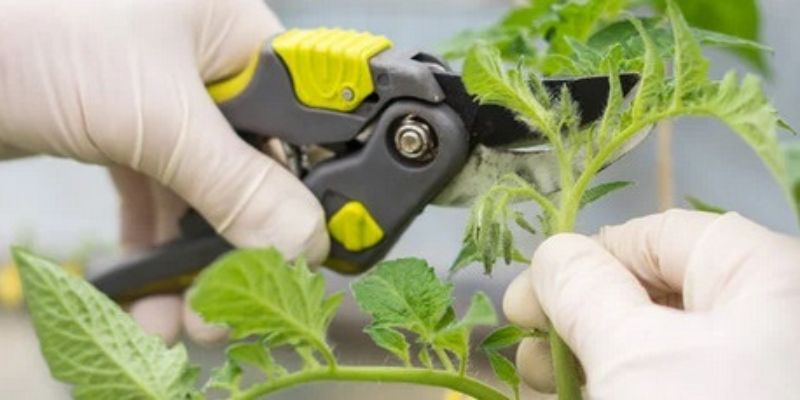
With the right timing and tools, you’re ready to master how to prune determinate tomato plants using these key techniques:
Step 1. Remove Lower Leaves and Branches
Eliminate any leaves or small shoots touching the ground to prevent diseases. Also, open up space around the base for air movement.
Step 2. Select Main Stems & Remove Others
Choose 3-4 of the healthiest, most upright stems and eliminate competing shoots to focus energy.
Step 3. Prune Above Outward Facing Leaf
Find the location right above the uppermost leaf pointing away from the center and cut side stems back to this junction point.
Step 4. Remove Interior Small Growth
Thin out cramped inner foliage and stems to allow light penetration and airflow into the center of plants.
Step 5. Reduce Topped Stems by 1/3
Pinch or cut back the tips of established main stems by about one-third after blossom clusters form to encourage more branching.
Step 6. Maintain Umbrella Shape
Keeping plants wider at the bottom and narrower on top allows ample light exposure for all foliage and ripening tomatoes.
By properly thinning out determinate varieties using these methods, you maximize yield potential in a compact space.
Pruning Techniques for Determinate Tomatoes
Now that you know how to prune determinate tomatoes to maximize yields, here are some tried-and-tested pruning techniques to help you achieve tomato perfection:
The Art of Gentle Pruning
When it comes to pruning your determinate tomatoes, a gentle touch is key. Always use clean, sharp pruners or scissors to make precise cuts. Avoid tearing or ripping branches, as this can damage the plant and leave it susceptible to disease or pests.
The Importance of Airflow
As you prune, keep in mind the importance of airflow. Removing excess foliage and opening up the plant’s interior allows for better air circulation, which can help prevent fungal diseases and improve overall plant health.
Pruning Determinate Tomatoes for Support
If you’re growing your determinate tomatoes in cages or with some form of support system, be sure to prune with this in mind. Carefully guide the main stems and branches through the cage or tie them to the support as needed. This not only keeps your plants tidy but also ensures that those heavy fruit clusters will have the support they need as they develop.
Common Pruning Mistakes to Avoid
It’s just as important to know what NOT to prune on determinate tomatoes. Here are common missteps:
- Removing too much foliage – Can stress plants, cause sunscald on fruit or inhibit photosynthesis
- Cutting away blooming trusses – Eliminates potential tomatoes so avoid pruning these productive branches
- Topping plants too early – Can limit fruit development if pruned before 4-6 main stems establish
- Leaving lower diseased leaves – Spreads infection to upper vegetation and developing tomatoes
- Pruning too late in season – Causes determinate plants to produce more foliage overripe fruit
Carefully removing only what’s needed using proper techniques keeps plants healthy and productive.
Signs Your Tomato Plants Need Pruning
As a seasoned gardener with years of experience tending to tomato plants, I can attest to the importance of proper pruning techniques. Tomatoes hold a special place in many home gardens and commercial operations, making them a beloved crop that requires careful attention to ensure optimal growth and bountiful yields. When it comes to determinate tomato varieties, known for their compact stature and concentrated fruiting period, recognizing the telltale signs that indicate the need for pruning is crucial.
1. Overcrowded Interior Foliage
One of the most noticeable indicators is an overcrowded interior, where the lush foliage becomes dense and tangled, obstructing the much-needed penetration of sunlight and air circulation. This situation can create a cozy haven for fungal diseases and pesky pests to thrive, compromising the plant’s overall well-being. Judiciously pruning away the excess foliage from the center of the plant promotes better light exposure and improved airflow, reducing the risk of such unwelcome visitors.
2. Leggy Stems with Sparse Leaves
Another sign that catches my eye is the presence of leggy stems with sparse foliage. Sometimes, tomato plants can produce these long, spindly stems that lack their characteristic lush leaf coverage. Not only does this condition make the plant appear a bit disheveled, but it also suggests an inefficient distribution of the plant’s resources. By selectively pruning these leggy stems, you can gently nudge the plant to focus its energy on developing a bushier, more compact growth habit, leading to a stronger and more productive plant overall.
3. Lower Leaves Touching Soil
It’s also important to keep a watchful eye on the lower leaves of your tomato plants. If these leaves are touching the soil, they become vulnerable to soil-borne diseases and can act as a gateway for infections to spread upwards through the plant’s vascular system. Removing these lower leaves, a process affectionately known as “suckering,” helps prevent disease transmission and improves air circulation around the plant’s base, ensuring a healthier environment for growth.
4. Branches Crossing Each Other
Another telltale sign that pruning is needed is when branches start crossing or rubbing against each other. This situation can lead to physical damage, creating potential entry points for pathogens and hindering the plant’s ability to distribute nutrients effectively throughout its structure. By selectively pruning the crossing branches, you promote better air circulation and prevent potential issues that could arise from this unintended branch-on-branch friction.
5. Slow Flower or Fruit Development
Finally, if you notice a slowdown in flower or fruit development, it may be an indication that the plant’s resources are being directed towards excessive vegetative growth at the expense of its reproductive efforts. In such cases, judiciously pruning back the fast-growing vegetation can help re-balance the plant’s energy, redirecting it towards the production of vibrant blossoms and, ultimately, the development of those delicious tomatoes we all crave.
Maintaining healthy determinate tomato plants requires a keen eye, a gentle touch, and a willingness to intervene when necessary. By recognizing these telltale signs and employing proper pruning techniques, you can nurture your determinate tomato plants to thrive, producing an abundant harvest of flavorful fruits for your culinary delights and the joy of sharing with loved ones.
Benefits of Pruning Determinate Tomatoes

You’re growing determinate tomatoes? That’s awesome! Do you know the big secret to getting tons of delicious tomatoes? PRUNING! It might seem weird to cut back the plant, but pruning is a total game-changer. Let me break it down for you:
1. Higher Tomato Yields
First up, pruning means more tomatoes for you! By snipping off extra leaves and stems, the plant can put all its energy into making lots of big, juicy fruits instead of unnecessary growth. It’s like the plant takes a deep breath and says “Okay, let’s do this!”
2. Improved Fruit Quality
But it’s not just about quantity, pruning also makes the tomatoes taste way better. With proper pruning, the plant gets more sunlight and airflow which helps it grow plump, flavorful tomatoes that’ll make your taste buds dance. Mmm, can you imagine biting into one of those beauties straight from the vine? Delicious!
3. Better Disease Resistance
Another cool thing? Pruning determinate tomato plants helps prevent plant diseases. When you thin out the inside branches, it reduces humidity and creates space for sprays to reach every leaf. It’s like giving the plant a force field against nasty fungus and bugs! Genius, right?
4. Easier Harvesting
Pruning even makes harvesting a breeze! No more wrestling through a jungle of vines. Just trim off those low-hanging branches, and boom – easy access to grab your tomatoes. The plant is practically handing them to you on a silver platter.
5. Enhanced Nutrient Absorption
Last but not least, pruning helps the plant absorb nutrients better from the soil. It’s like giving the roots a fresh start to really soak up all the good stuff and transport it to those developing fruits. More nutrients = bigger, tastier tomatoes. Win-win!
Alternatives to Pruning Determinates
As a fellow gardening enthusiast, I completely understand the desire to enjoy a bountiful tomato harvest while juggling the demands of a busy life. Despite learning how to prune determinate tomato plants, it can be a time-consuming task. Luckily, I will share with you alternatives that can provide a satisfactory yield without the need for meticulous hands-on pruning.
i. Choose Naturally Compact Cultivars
For those seeking a low-maintenance approach, consider cultivating naturally compact tomato varieties. These modern wonders, such as the delightfully petite ‘Tiny Tim,’ have been carefully bred to exhibit a contained growth habit, requiring little to no pruning at all. Can you imagine the sheer delight of enjoying a bountiful harvest without the need for constant trimming and shaping? It’s a gardener’s dream come true!
ii. Use Specialized Cages
If you prefer a more traditional tomato plant stature, there are specialized cages or supports designed specifically for our beloved tomatoes. These conical or pyramid-shaped structures provide built-in support, gently guiding the plant’s growth and alleviating the need for excessive pruning. With their sturdy frames, these cages allow the plant to thrive while maintaining a neat and tidy appearance, bringing a sense of order to your garden.
iii. Rely on Leaf Removal Alone
For those gardeners willing to engage in some light maintenance, a simple yet effective approach is to focus solely on leaf removal. By carefully eliminating the lower leaves and allowing the short, bushy canopy to grow as-is, you can achieve decent results with significantly less effort. This method strikes a harmonious balance between minimal intervention and maintaining a productive plant, ensuring a rewarding experience for the dedicated gardener.
iv. Allow Some Crowding
However, it’s important to note that while pruning can be beneficial, plants that are pruned too heavily may become stressed and struggle to thrive. If you find yourself overwhelmed by the pruning task, it is perfectly acceptable to leave a certain degree of interior crowding. A slight tangle within the plant’s structure can provide a buffer against over-pruning, allowing the plant to maintain its natural vigor and vitality.
Ultimately, the key to a successful tomato harvest lies in understanding your own gardening preferences and limitations. By exploring these alternatives to traditional pruning methods, you can tailor your approach to suit your lifestyle and ensure a rewarding and enjoyable gardening experience. Whether you choose compact cultivars, specialized cages, leaf removal, or a balanced approach to crowding, the joy of savoring homegrown tomatoes remains within reach, a testament to your dedication and love for the art of gardening.
Conclusion
Regular pruning keeps determinate tomato plants healthy and drives higher yields in small spaces. Just be sure to use the proper techniques and timing tailored specifically to these bushy compact tomato varieties. Equipped with quality tools, some gardening gloves, and this advice on how to prune determinate tomato plants, you’ll be rewarded with a bountiful crop of ripe tomatoes!

Michael Glenn is a certified arborist and horticultural expert with over 15 years of experience in the landscape industry. His passion for plants and trees has led him to become a sought-after authority on pruning and trimming techniques. Glenn’s in-depth knowledge of proper pruning methods, timing, and tools has helped countless homeowners and professionals maintain healthy, aesthetically pleasing gardens and landscapes.
In addition to sharing his pruning expertise through practical tips, step-by-step guides, and expert advice, Glenn is also a respected author of pruning tool buying guides. His comprehensive reviews and comparisons ensure readers can make informed decisions when investing in quality loppers, pruning shears, saws, and other essential equipment. With a deep understanding of plant biology and sustainable practices, Glenn’s writing empowers audiences with the knowledge needed to properly care for green spaces.

